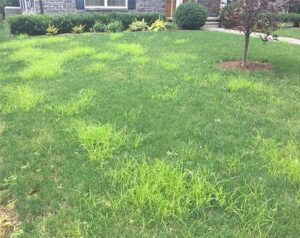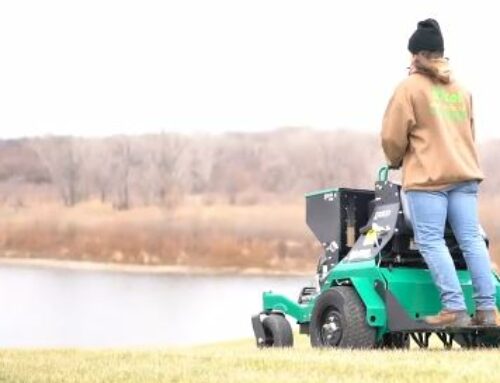Yellow Nutsedge “The Lime Green Grass invader”

It is that time of year, Yellow Nutsedge is starting to show up within our Des Moines Metro lawns. We are seeing a lot of it throughout West Des Moines and Urbandale suburbs especially in the irrigated lawns. As the Lime green grass invader loves the heat and moisture. Below is some information about the weed, what you can do about it, and of course if you need help, we have options that are safe for family, pets, and lawns. Just drop us a note, Nutsedge Help, and we will be happy to help.
What is Yellow Nutsedge:
Yellow nutsedge (Cyperus esculentus), commonly known as yellow nutgrass, is a perennial weed that has plagued gardeners, farmers, and homeowners for centuries. Despite its vibrant appearance, this persistent plant is a formidable adversary, capable of surviving and thriving in various environments.
What does it look like:
Yellow nutsedge stands out due to its distinctive appearance, growth rate and pattern. It features grass-like leaves with a triangular cross-section, reaching up to three feet in height if left alone. Its stem is solid and smooth, typically yellowish, or straw-colored, while the underground structures called tubers are light brown and shaped like small, elongated bulbs. These tubers play a significant role in the plant’s persistence and spread, allowing it to regenerate even after attempts to remove it.
Habitat and Growth Habits
Native to regions with warm climates, yellow nutsedge is considered an invasive species to many, including Iowa. It thrives in wet or poorly drained soils. In Iowa, yellow nutsedge can be found in lawns, gardens, agricultural fields, and other disturbed areas where the conditions are favorable for its growth. Its ability to adapt to different environments and its persistent nature make it a challenging weed to control. This weed is particularly fond of areas with excessive moisture, such as poorly irrigated lawns or waterlogged soils. Yellow nutsedge grows rapidly during the summer months, often outcompeting desirable plants for resources.
Reproduction and Spread:
Yellow nutsedge possesses an efficient reproductive strategy, enabling it to spread and colonize new areas rapidly. It reproduces through underground tubers, which can remain dormant for several years. When conditions are favorable, these tubers sprout new shoots that emerge from the soil. Additionally, the plant produces small, inconspicuous flowers, which develop into nut-like seeds that further contribute to its spread.
Challenges and Impacts:
The presence of yellow nutsedge poses several challenges and impacts to both agricultural and residential landscapes. In lawns and gardens, it detracts from the aesthetic appeal and can quickly overrun desired vegetation. As it out competes the grass for nutrients, water, and sunlight, significantly stressing the lawn. The persistence of yellow nutsedge makes it particularly challenging to eradicate once it has established a foothold.
Control and Management:
Managing yellow nutsedge requires a combination of strategies aimed at preventing its spread and reducing its vigor. Some effective control methods include:
- Cultural Practices: Promote proper drainage, avoid overwatering, and maintain healthy turf or garden beds to minimize opportunities for yellow nutsedge to establish and thrive.
- Physical Removal: Hand pulling or digging out the tubers can be effective for small infestations, but it is essential to remove the entire plant, including the tubers, to prevent regeneration.
- Mulching: Applying a layer of organic mulch can help suppress the growth of yellow nutsedge by reducing light penetration and inhibiting its ability to emerge.
- Herbicides: Selective herbicides specifically formulated for nutsedge control can be effective when applied according to label instructions. It is important to choose herbicides that are safe for surrounding desirable plants.
Yellow nutsedge is undoubtedly a challenging weed to combat, given its adaptability and persistence. However, by understanding its growth habits and employing a combination of preventive measures and control strategies, it is possible to manage its impact effectively. By staying vigilant and taking proactive steps, gardeners and homeowners can reclaim their landscapes from the grip of this tenacious weed.
Hopefully this educational article was helpful in identifying this pesky weed within your lawns. If you are looking for more informative information like this in the feature, make sure to follow us on Facebook, and check back often for more pro tips. Oh course if you need help with weed pressure within your turf, fill out our form for a FREE PROPOSAL!
Share This Story, Choose Your Platform!
Recent Posts
Is Winter the Best Time for Pruning?
Winter pruning is indeed the best time for Tree pruning, if pruning is [...]
Ultimate Guide to Lawn Aeration and Overseeding Mastery
A healthy, lush lawn doesn’t just happen—it takes care and the right approach. [...]
The Superpower of Lawn Aeration: Unlocking the secret to a vibrant Lawn
When you envision a stunning, vibrant lawn, what springs to mind? Probably a lawn [...]
Yellow Nutsedge “The Lime Green Grass invader”
It is that time of year, Yellow Nutsedge is starting to show up within our [...]
The Art of Pruning Hydrangea’s
Pruning Hydrangea's If you're growing hydrangeas at your West Des Moines home, let's keep [...]
Achieving that Perfect Urbandale Lawn in 5 Steps
Maintaining a perfect Urbandale lawn is about more than just regular watering and fertilization. [...]










